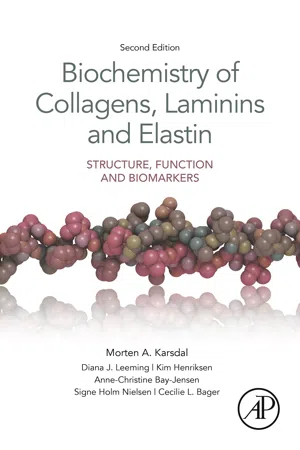
Biochemistry of Collagens, Laminins and Elastin
Structure, Function and Biomarkers
Morten Karsdal
- 434 páginas
- English
- ePUB (apto para móviles)
- Disponible en iOS y Android
Biochemistry of Collagens, Laminins and Elastin
Structure, Function and Biomarkers
Morten Karsdal
Información del libro
There are 28 different collagens, with 46 unique chains, which allows for a collagen for each time and place. Some collagens are specialized for basement membrane, whereas others are the central structural component of the interstitial matrix. There are eight collagens among the 20 most abundant proteins in the body, which makes these molecules essential building blocks of tissues. In addition, lessons learned from monogenomic mutations in these proteins result in grave pathologies, exemplifying their importance in development. These molecules, and their post-translationally modified products serve as biomarkers of diseases in a range of pathologies associated with the extracellular matrix.
Biochemistry of Collagens, Laminins, and Elastin: Structure, Function, and Biomarkers, Second Edition provides researchers and students current data on key structural proteins (collagens, laminins, and elastin), reviews on how these molecules affect pathologies, and information on how selected modifications of proteins can result in altered signaling properties of the original extracellular matrix component. Further, it discusses the novel concept that an increasing number of components of the extracellular matrix harbor cryptic signaling functions that may be viewed as endocrine function, and it highlights how this knowledge can be exploited to modulate fibrotic disease.
- Provides an updated comprehensive introduction to collagen and structural proteins
- Gives insight into emerging analytical technologies that can detect biomarkers of extracellular matrix degradation
- Includes seven new chapters, including one on how collagen biomarkers are used in clinical research to support drug development and in precision medicine
- Contains insights into the biochemical interactions and changes to structural composition of proteins in disease states
- Proves the importance of proteins for collagen assembly, function, and durability
Preguntas frecuentes
Información
Type I collagen
Keywords
Summary
| Type I collagen | Description | References |
|---|---|---|
| Gene name and number | COL1A1, location 17q21.3-q22 COL1A2, location 7q21.3-22.1 | Gene ID 1277 Gene ID 1278 |
| Mutations with diseases in man | Osteogenesis imperfecta I–IV Ehlers-Danlos Caffey disease | [55–59] |
| Tissue distribution in healthy states | Ubiquitous | [1] |
| Tissue distribution in pathological affected states | Ubiquitous | [1] |
| Special domains | Like other fibrillar collagens it consist of three NC domains (1–3) + two Col domains (1–2) | [3,4] |
| Special neoepitopes | N- and C-terminal propeptides, and N- and C-terminal degradation peptides | [3,4] |
| Protein structure and function | Type I collagen is a heterotrimer molecule in most cases composed of two α1 chains and one α2 chain, albeit an α1 homotrimer exists as a minor form. Each chain consists of more than 1000 amino acids, glycines at every third position of the helical domain are crucial for the helix Essential component for the mechanical competence of the bone extracellular matrix, but also a key structural component of many other tissues. Full function not yet clear | [3,4] [7,9,60–62] |
| Binding proteins | Integrins, proteoglycans, and many more | [7,9] |
| Known central function | The main organic component of bone, indispensable for bone integrity | [7,9] |
| Animals models | COL1A2-deficient mice (oim mice), collagenase-resistant collagen I mouse | [3,4] |
| Biomarkers | Alpha and beta-CTX-1, NTX, ICTP, PINP, PICP, C1M | [25,26] |


Índice
- Cover image
- Title page
- Table of Contents
- Copyright
- List of contributors
- Foreword
- Preface
- Acknowledgments
- List of abbreviations
- Introduction
- Chapter 1. Type I collagen
- Chapter 2. Type II collagen
- Chapter 3. Type III collagen
- Chapter 4. Type IV collagen
- Chapter 5. Type V collagen
- Chapter 6. Type VI collagen
- Chapter 7. Type VII collagen
- Chapter 8. Type VIII collagen
- Chapter 9. Type IX collagen
- Chapter 10. Type X collagen
- Chapter 11. Type XI collagen
- Chapter 12. Type XII collagen
- Chapter 13. Type XIII collagen
- Chapter 14. Type XIV collagen
- Chapter 15. Type XV collagen
- Chapter 16. Type XVI collagen
- Chapter 17. Type XVII collagen
- Chapter 18. Type XVIII collagen
- Chapter 19. Type XIX collagen
- Chapter 20. Type XX collagen
- Chapter 21. Type XXI collagen
- Chapter 22. Type XXII collagen
- Chapter 23. Type XXIII collagen
- Chapter 24. Type XXIV collagen
- Chapter 25. Type XXV collagen
- Chapter 26. Type XXVI collagen
- Chapter 27. Type XXVII collagen
- Chapter 28. Type XXVIII collagen
- Chapter 29. Laminins
- Chapter 30. Elastin
- Chapter 31. The collagen chaperones
- Chapter 32. Collagen diseases
- Chapter 33. The signals of the extracellular matrix
- Chapter 34. The roles of collagens in cancer
- Chapter 35. Use of extracellular matrix biomarkers in clinical research
- Chapter 36. Common confounders when evaluating noninvasive protein biomarkers
- Chapter 37. Implementation of collagen biomarkers in the clinical setting
- Index